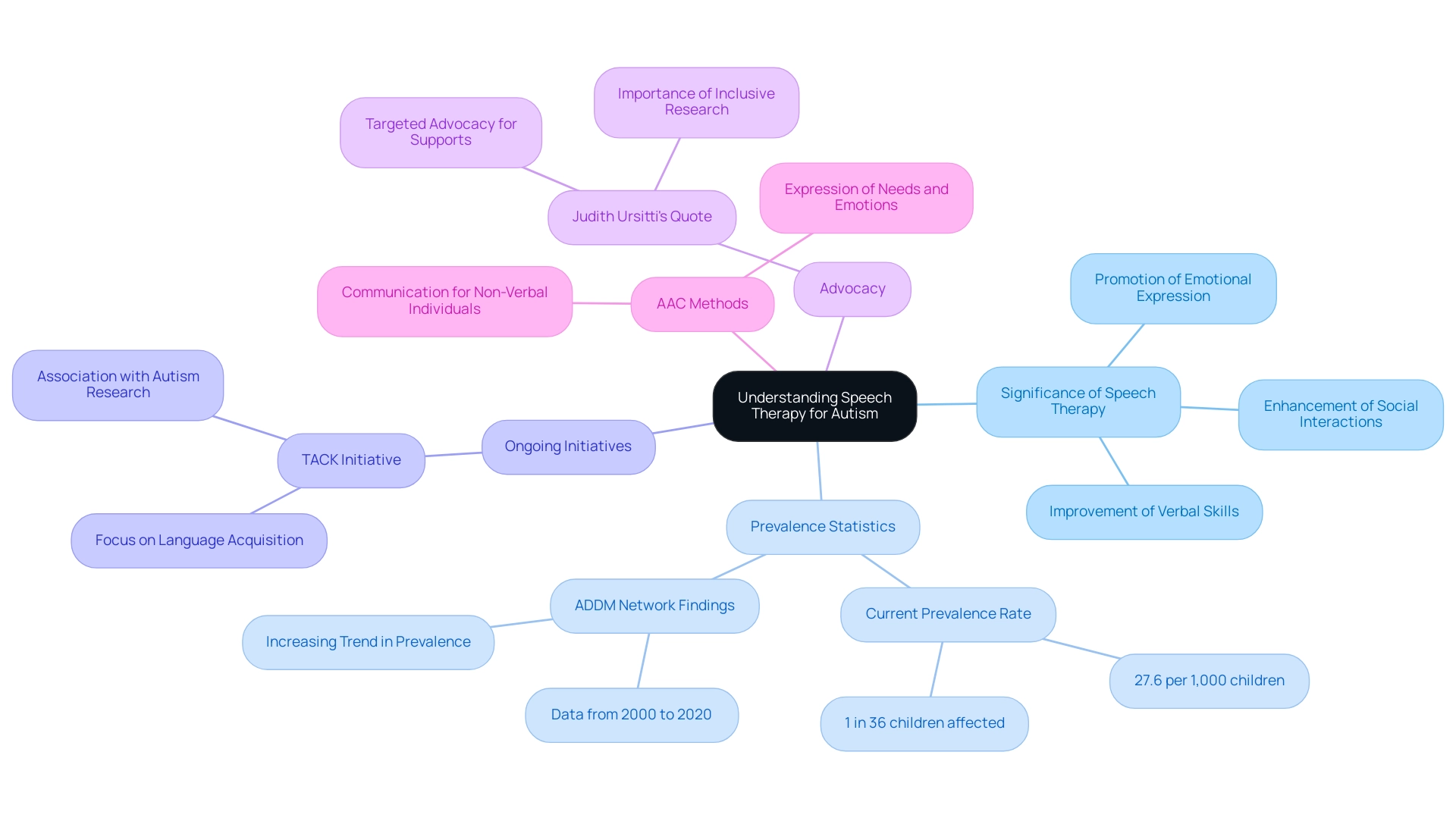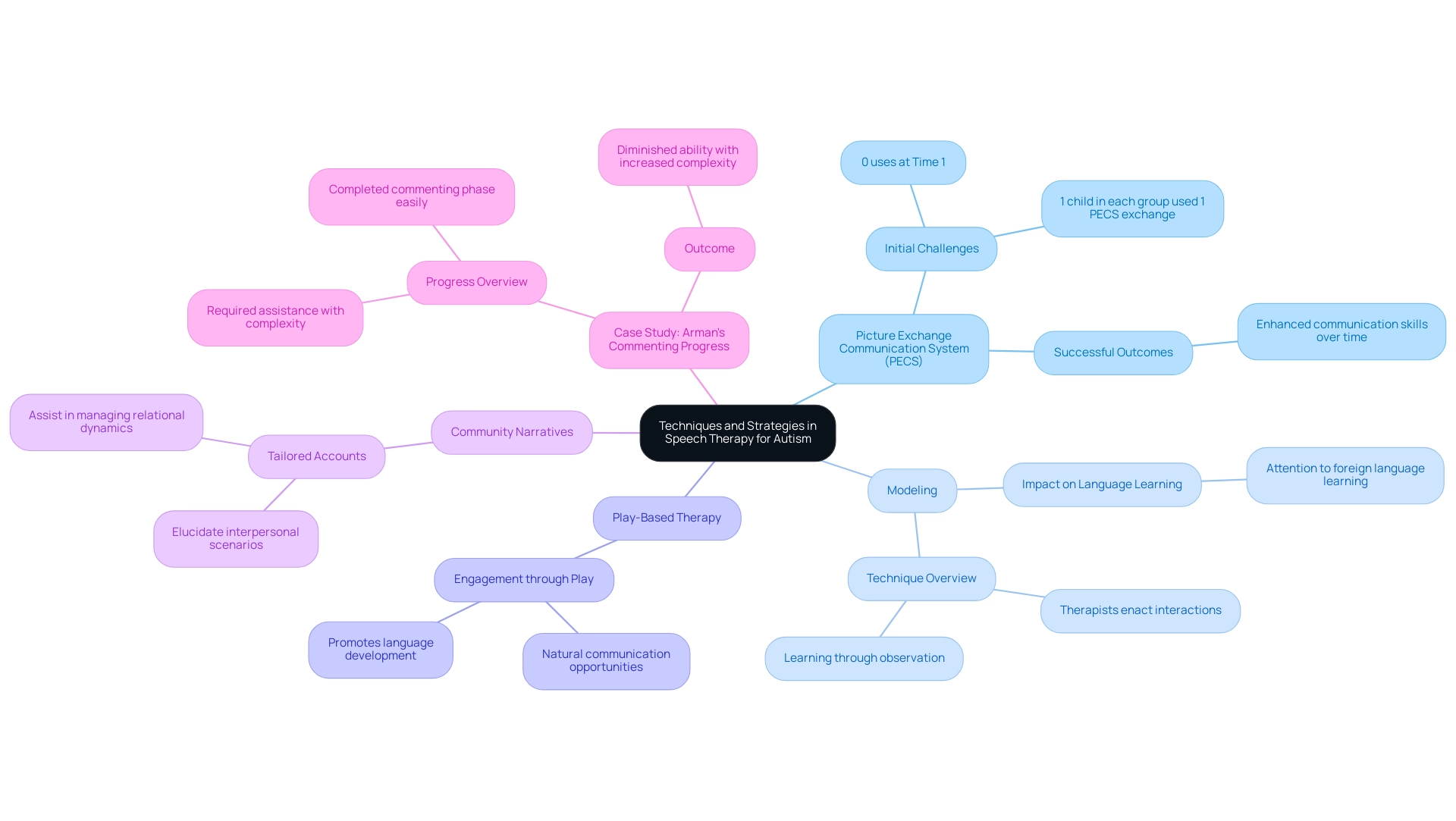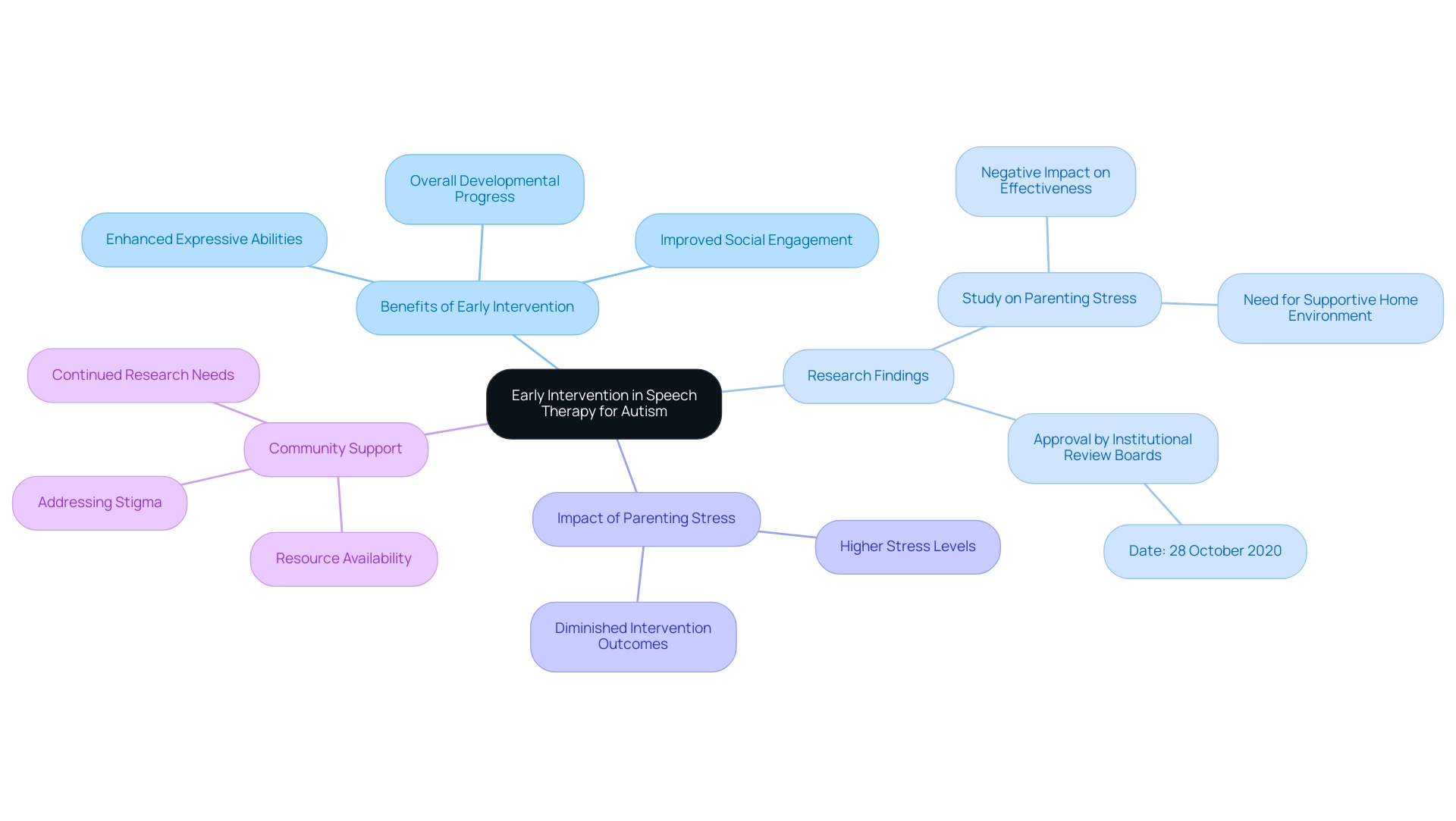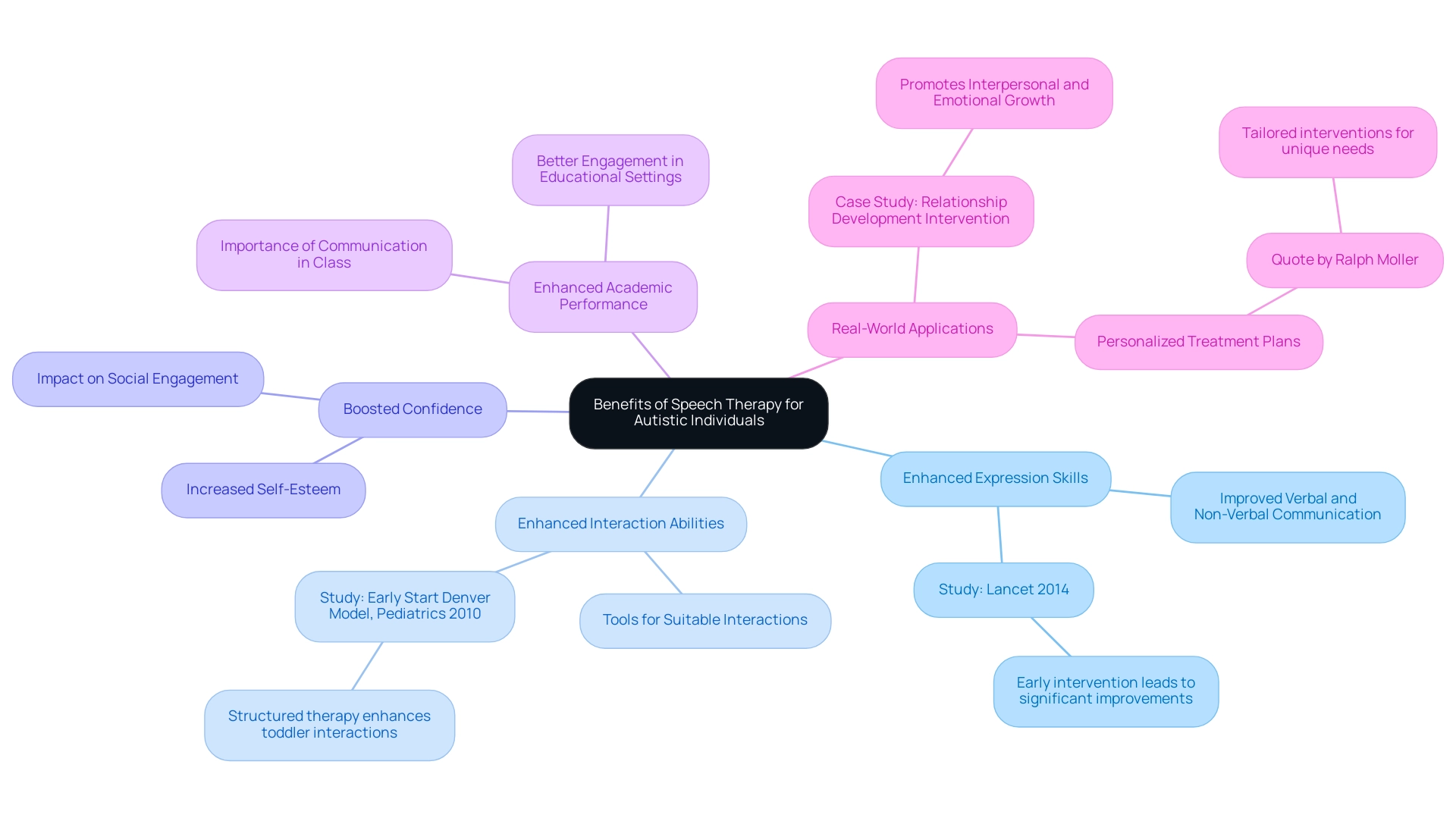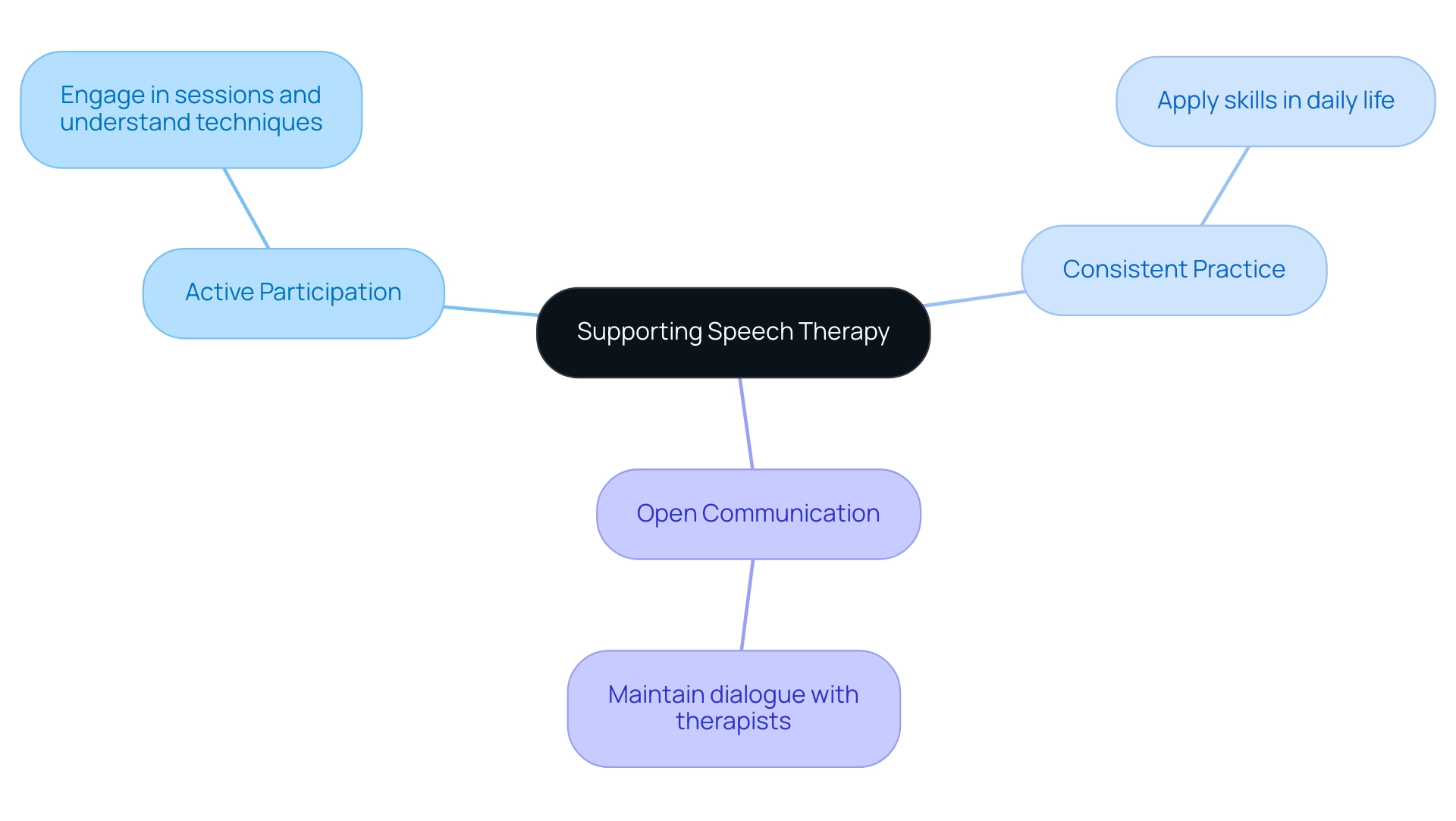Introduction
Speech therapy plays a pivotal role in supporting individuals with Autism Spectrum Disorder (ASD), a condition that affects a significant number of children today. As communication challenges can severely hinder social interactions and emotional expression, tailored speech therapy interventions are essential for enhancing both verbal and non-verbal communication skills.
This article delves into the various techniques and strategies employed in speech therapy, the importance of early intervention, and the numerous benefits that arise from effective communication support.
Moreover, it underscores the crucial role of families and caregivers in fostering a nurturing environment that complements therapeutic efforts, ensuring that individuals on the autism spectrum can thrive in their communication abilities.
1. Understanding Speech Therapy: A Vital Resource for Autism
Speech therapy for autism serves as a crucial intervention for individuals experiencing interaction difficulties, particularly those diagnosed with Autism Spectrum Disorder (ASD), which currently affects approximately 27.6 per 1,000 children, or about 1 in 36 youngsters. This condition can severely affect one's ability to express thoughts and understand interpersonal cues, leading to significant barriers in interaction. Customized speech intervention aims to improve verbal skills, using personalized methods to address the distinct requirements of every person.
Speech therapy for autism is essential not only for enhancing verbal exchanges but also for promoting social interactions and emotional expression among those with autism. The
Tackling Acquisition of Language in Kids (TALK) Initiative exemplifies ongoing efforts to advance research in this area, addressing the complexities of language acquisition in children with autism. Additionally, the ADDM Network's findings from 2000 to 2020 highlight the increasing prevalence of ASD, underscoring the urgent need for effective speech therapy for autism interventions.
Furthermore, Judith Ursitti, co-founder and president of the Profound Autism Alliance, aptly states,
The continuing recognition of profound autism will open the doors to more inclusive research like the CDC’s. Only then can targeted advocacy increase access to critically needed supports and services for this marginalized population.
This emphasizes the essential role of advocacy in ensuring that people on the autism spectrum receive the communication support they need to thrive.
Furthermore, Augmentative and Alternative Communication (AAC) methods are essential for those who cannot speak, offering them means to actively express their needs, desires, and emotions, further highlighting the significance of holistic speech support strategies.
2. Techniques and Strategies in Speech Therapy for Autism
The various techniques included in speech therapy for autism address the unique requirements of each individual. Among these are:
-
Picture Exchange Communication System (PECS): This method employs visual supports to enhance interaction, enabling people to convey their needs and wants effectively.
Initially, there were 0 uses of PECS in all children at Time 1, with only one child from each group utilizing it. Despite these initial challenges, its implementation has shown promise in enhancing communication skills over time.
-
Modeling: In this technique, therapists enact appropriate speech and interpersonal interactions, providing a framework for individuals to learn through observation. Recent evaluations highlight the success of modeling techniques, as they allow autistic children to grasp complex interactions in a structured manner, fostering both verbal and interpersonal skills. As Wire (2005) noted, the increasing number of students with autism who seek to learn foreign languages invokes teachers’ attention and concern to look for alternatives to be employed.
-
Play-Based Therapy: This engaging method leverages play to create natural communication opportunities, making the learning process enjoyable and effective. Such interactions not only promote language development but also encourage community engagement in a relaxed setting.
-
Community Narratives: Tailored accounts created to elucidate interpersonal scenarios and suitable reactions assist people in managing intricate relational dynamics. These stories serve as valuable tools for understanding context and expectations in various interactions.
Through these strategies, therapists significantly enhance both verbal and non-verbal interaction capabilities in their patients, which profoundly impacts individuals' abilities to connect and engage with others, particularly through speech therapy for autism. The work of professionals like Wire (2005) underscores the importance of adapting these techniques, especially as the demand grows for
effective speech therapy for autism among students. For instance, in the case study titled 'Phase 6 (Commenting) - Arman's Commenting Progress,' Arman completed the commenting phase easily up to sessions 7 and 8, but required assistance as the number of words and structures increased, demonstrating the practical challenges associated with PECS.
The changing environment of autism treatment as of 2024 persists in showcasing the significance of creative strategies such as PECS, modeling, and play-oriented methods in promoting interaction and interpersonal abilities.
3. The Importance of Early Intervention in Speech Therapy
Early intervention in speech therapy for autism is crucial for children diagnosed with autism spectrum disorders (ASD), as substantial evidence suggests that initiating support at an earlier age significantly enhances its effectiveness. During the formative years, children are in a pivotal developmental stage, demonstrating an impressive capacity to acquire new skills rapidly. Research shows that early interventions, such as speech therapy for autism, can result in significant enhancements in expressive abilities, interpersonal skills, and overall developmental progress.
By proactively addressing speech challenges, therapists can help reduce the risk of long-term interaction difficulties, thereby fostering enhanced outcomes in social engagements and academic performance. Additionally, a study titled 'Parenting Stress Reduces the Effectiveness of Early Teaching Interventions for Autistic Spectrum Disorders,' approved by the Institutional Review Boards of the Research & Development Institute 'Life Activities Advancement Center' on 28 October 2020, underscores the vital role of a supportive home environment. This research found that elevated levels of parenting stress detrimentally impacted the effectiveness of early interventions, highlighting the need for community support alongside therapeutic efforts.
The authors have declared that no competing interests exist, further enhancing the credibility of these findings. As reaffirmed by Fayge Orzel, an expert in the field,
Our expert team is ready to support your child’s development and well-being. We are committed to providing customized ABA treatment solutions that promote growth.
Therefore, prioritizing early speech therapy for autism not only addresses immediate expression challenges but also lays the foundation for long-term developmental achievement. Furthermore, it is essential to recognize the challenges in diagnosing ASD, which include limited resources and stigma, necessitating continued research and community support.
4. Benefits of Speech Therapy for Autistic Individuals
Speech therapy for autism offers numerous benefits, focusing on essential aspects of interaction and social skills. The following benefits are particularly noteworthy:
-
Enhanced Expression Skills: By concentrating on both verbal and non-verbal interactions, speech therapy improves a person's ability to convey thoughts and emotions effectively.
A study published in the Lancet in 2014 found that early intervention strategies can lead to significant improvements in communication skills among autistic children, highlighting the importance of timely therapeutic support.
-
Enhanced Interaction Abilities: Therapy provides people with the tools needed for suitable interactions, thereby fostering the growth of connections with peers and family members. The randomized controlled trial of the Early Start Denver Model published in Pediatrics in 2010 demonstrated that structured speech therapy for autism significantly enhanced interaction in toddlers, leading to more fulfilling and supportive connections.
-
Boosted Confidence: As interaction skills improve, many individuals experience a notable increase in self-esteem and confidence during social engagements. This newfound confidence can significantly impact their willingness to communicate and interact with others.
-
Enhanced Academic Performance: Improved interpersonal skills often translate into better engagement in educational environments, supporting academic success. Effective communication is fundamental to participating in classroom discussions and collaborative activities.
-
Real-World Applications: The case study on
Relationship Development Intervention demonstrates how customized speech strategies can promote interpersonal and emotional growth in people with autism. By applying tailored approaches, therapists can effectively tackle the distinct challenges encountered by each person, leading to significant advancement.
Together, these advantages emphasize the essential role of speech therapy for autism within the comprehensive assistance framework for autistic people. Recent studies highlight the effectiveness of customized speech therapy for autism in fostering communication skills and social interactions. As Ralph Moller aptly stated,
A personalized treatment plan takes into account the unique needs and preferences of the individual, allowing for tailored interventions that are most effective for their specific challenges.
Such personalized approaches are essential for maximizing the potential benefits of treatment.
5. Supporting Speech Therapy: The Role of Families and Caregivers
Families and caregivers are essential to the support of speech therapy for autism, significantly enhancing the effectiveness of sessions and fostering a nurturing environment for learning at home. Research indicates that the average age of diagnosis for children from lower-income households is 4.7 years, compared to 5.2 years in higher-income households, highlighting disparities that can affect access to early intervention services. To maximize the benefits of speech treatment, caregivers can adopt several effective strategies:
- Active Participation: Families should actively engage in sessions, gaining a clear understanding of the techniques being employed. This involvement allows them to reinforce concepts and strategies used by the therapist.
- Consistent Practice: Encouraging the application of skills acquired during treatment in daily life is essential. This consistent practice helps solidify learning and promotes the generalization of skills across different contexts.
- Open Communication: Maintaining a dialogue with therapists regarding the child's progress and any challenges encountered is crucial. This communication enables speech therapy for autism to be tailored to meet the specific needs of the child, fostering a more personalized approach.
By fully immersing themselves in the therapeutic process, families can significantly enhance speech therapy for autism outcomes, providing autistic individuals with the necessary support to thrive. Furthermore, engaging in shared experiences and utilizing parental assessment measures can yield valuable insights into the effectiveness of various coping strategies and support systems, ultimately benefiting the child’s development. The data collected from parents through instruments like the
Family Problems Questionnaire and General Health Questionnaire highlight both the objective and subjective burdens they face, emphasizing the critical role of family involvement in the therapeutic journey.
Conclusion
Speech therapy is an essential resource for supporting individuals with Autism Spectrum Disorder (ASD), addressing the unique communication challenges they face. The article highlights the importance of tailored interventions, which not only enhance verbal and non-verbal communication skills but also facilitate social interactions and emotional expression. Techniques such as the Picture Exchange Communication System (PECS), modeling, play-based therapy, and social stories are pivotal in helping autistic individuals navigate complex communication landscapes.
Early intervention emerges as a crucial factor in maximizing the effectiveness of speech therapy. Research underscores that initiating therapy during formative years leads to significant improvements in communication abilities and social skills, ultimately fostering better academic performance and self-confidence. The role of families and caregivers is equally vital, as their active participation and support can amplify the benefits of therapeutic approaches, ensuring a nurturing environment for continued growth.
In summary, the comprehensive support provided by speech therapy not only addresses immediate communication barriers but also lays the groundwork for long-term developmental success. By prioritizing early intervention and fostering collaboration among families, therapists, and advocacy groups, individuals on the autism spectrum can achieve meaningful progress in their communication skills, enriching their social interactions and overall quality of life.
